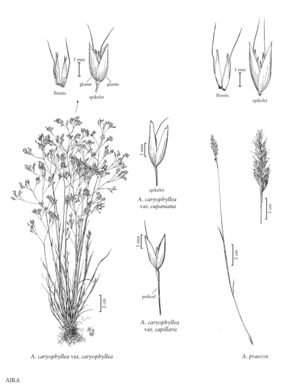Difference between revisions of "Aira caryophyllea var. capillaris"
imported>Volume Importer |
imported>Volume Importer |
||
| Line 46: | Line 46: | ||
|publication year= | |publication year= | ||
|special status= | |special status= | ||
| − | |source xml=https://bitbucket.org/aafc-mbb/fna-data-curation/src/ | + | |source xml=https://bitbucket.org/aafc-mbb/fna-data-curation/src/200273ad09963decb8fc72550212de541d86569d/coarse_grained_fna_xml/V24/V24_875.xml |
|subfamily=Poaceae subfam. Pooideae | |subfamily=Poaceae subfam. Pooideae | ||
|tribe=Poaceae tribe Poeae | |tribe=Poaceae tribe Poeae | ||
Latest revision as of 16:25, 11 May 2021
Pedicels 2-11.3 mm, usually 2-8 times as long as the spikelets, gradually thickening to the apices. Spikelets 1.7-2.5 mm, spreading, divergent from the secondary branches, often purplish to reddish-purple-tinged; rachillas not prolonged or vestigial. Glumes subequal, 1.7-2.5 mm, 1-veined, acute; lower lemmas 1.3-1.8 mm, apices bifid, teeth to 0.1 mm, awns absent or to 2.6 mm, straight or geniculate; lower paleas 1-1.3 mm; upper lemmas 1.7-2.1 mm, apices bifid, teeth 0.2-0.4 mm, awned, awns 2.1-3 mm, geniculate; upper paleas 1-1.3 mm; anthers 0.2-0.4 mm, yellow-orange or purple. Caryopses 0.9-1.2 mm long, about 0.3 mm wide, glabrous.
Discussion
Aira caryophyllea var. capillaris is native to Europe, northern Africa, and western Asia. It usually grows in dry to somewhat moist, sandy loam soils of grassy banks, woodland openings, and disturbed sites such as pastures and roadsides.
Aira caryophyllea var. capillaris is the correct name for this taxon at the varietal level. If treated at the species level, its correct name is Aira elegans Willd. ex Roem. & Schult.
Selected References
None.
